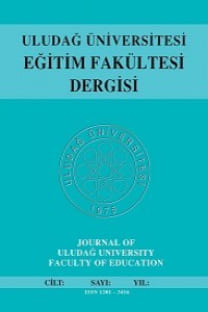An Analysis of Scores of Prospective Biology Teachers on the Factors of MSLQ
Aday biyoloji öğretmenleri, GÖSÖ, Öz-düzenleyici öğrenme
An Analysis of Scores of Prospective Biology Teachers on the Factors of MSLQ
Prospective biology teachers, MSLQ, Self-regulated learning,
___
- Büyüköztürk, Ş., Akgün, Ö.E., Özkahveci, Ö., and Demirel, F. (2004).The Validity and Reliability Study of the Turkish Version of Motivated Strategies for Learning Questionnaire. Educational sciences: Theory & Practice. 4 (2).
- Chen, C. S. (2002). Self-regulated Learning Strategies and Achievement in an Introduction to Information Systems Course. Information Technology, Learning, and Performance Journal. 20 (1).
- Douglas, L. (2006). Motivational Factors, Learning Strategies and Resource Management As Predictors of Course Grades. College Student Journal. 40 (2).
- Gredler, M. E. (2005). Learning and instruction: Theory into practice (5th ed.).Upper Saddle River, NJ: Pearson Education.
- Mallow, J.V. (1978). A science anxiety program. American Journal of Physics. 46 (8).
- Pintrich, P.R, & De Groot, E.V. (1990). Motivation and self-regulated learning components of classroom academic performance. Journal of Educational Psychology. 82 (1).
- Pintrich, P.R.(1999). The role of motivation in promoting and sustaining self- regulated learning. International Journal of Educational Research. 31.
- Pintrich, P.R. (2004). A conceptual framework for assessing motivation and self- regulated learning in college students. Educational Psychology Review. 16 (4).
- Pintrich, P. R. (2005). The role of goal orientation in self-regulated learning. In M. Boekaerts, P. R. Pintrich & M. Zeidner (Eds.), Handbook of Self- Regulation (pp. 451-502). Burlington, MA: Elseiver Academic Press.
- Sankaran, S. R. and Bui, T. (2001). Impact of Learning Strategies and Motivation on Performance: a Study in Web-Based Instruction. Journal of Instructional Psychology. 28 (3).
- Schunk, D. H. (2000). Learning theories: an educational perspective. New Jersey: Prentice-Hall.
- Weinstein C.E. & Mayer R.E., (1983). The Teaching of Learning Strategies. Innovation Abstracts, 5:32.
- Wolters, C.A. & Pintrich, P.R.(1998). Contextual differences in student motivation and self-regulated learning in mathematics, English and social studies classrooms. Instructional Science. 26:27-47.
- Yayın Aralığı: 3
- Başlangıç: 1986
- Yayıncı: Bursa Uludağ Üniversitesi Eğitim Fakültesi
Bilgisayar Öğretmenlerinin Bakış Açısıyla Yönetici ve Öğretmen Beklentileri
S. Sadi SEFEROĞLU, Cenk AKBIYIK
Hakan Şevki AYVACI, Çiğdem ŞAHİN
Semantic Relations in The Comparative Phraseological Units in English and Bulgarian
İlköğretim 6. Sınıf Türkçe Kitaplarındaki Kelime Grupları ve Öğretimi Üzerine Bir Değerlendirme
Süleyman EROĞLU, Nilay ÇAĞLAYAN
Ali Canip Yöntem'in Cumhuriyet Döneminde Edebiyat Öğretimi İçin Hazırladığı Ders Kitapları
Kontrbas Eğitiminde Çağdaş Türk Müziği Eserlerinin Yeri ve Değerlendirilmesi
İş Birliğine Dayalı Öğrenmenin Sosyal Bilgiler Dersinde Akademik Başarı Üzerine Etkisi
Ali Canip Yöntem’in eğitim ve edebiyat eğitimi hakkındaki düşünceleri
